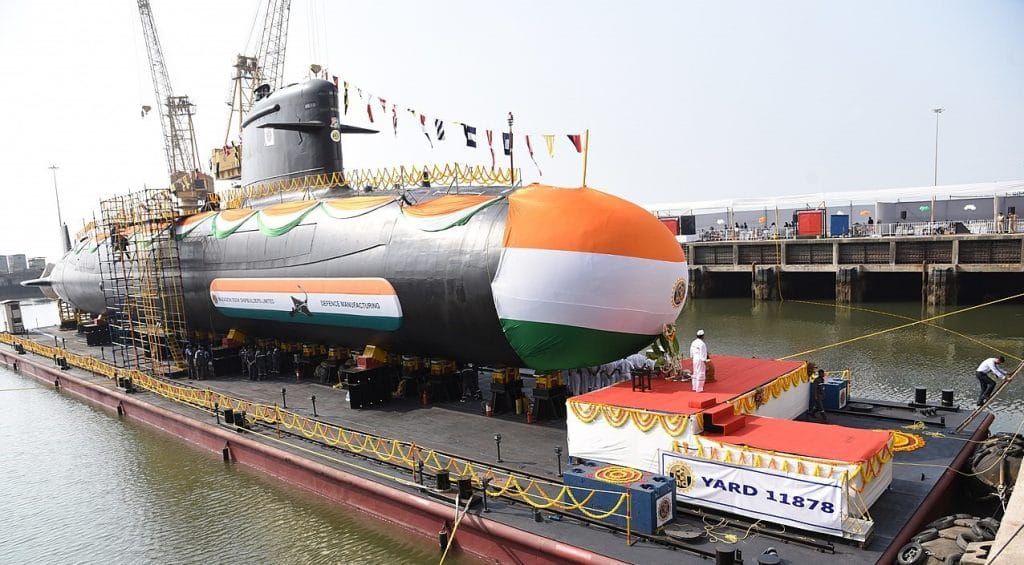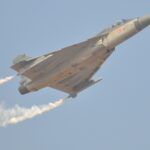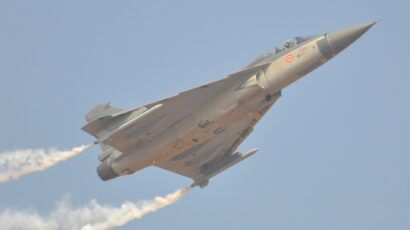India is building nuclear submarines and ICBMs. That’s a $14 billion mistake.
By Frank O’Donnell, Alexander K. Bollfrass | February 26, 2020
 India’s INS Vela, a diesel-electric attack submarine, seen in 2019. Aside from these attack submarines, India is in the process of building nuclear-powered, nuclear-armed submarines and has built two so far, but neither has begun patrols. It plans to build several more. Photo credit: Indian Ministry of Defense.
India’s INS Vela, a diesel-electric attack submarine, seen in 2019. Aside from these attack submarines, India is in the process of building nuclear-powered, nuclear-armed submarines and has built two so far, but neither has begun patrols. It plans to build several more. Photo credit: Indian Ministry of Defense.
Despite struggling to modernize outdated conventional forces with the current defense budget, India is investing in two new nuclear platforms. The first is the Arihant-class submarine fleet, the second the mobile Agni-V intercontinental ballistic missile. Together, their combined price tag will top $14 billion. Is this money well spent?
Pessimism about its strategic balance with China is driving India’s nuclear arms procurement. An altercation between troops of both countries in summer 2017, which came to be known colloquially as the Doklam crisis, stimulated introspection among Indian officials and experts about the future of the relationship with China. Politically, the Indian strategic community has largely concluded that the peaceful resolution of border disputes has become less likely, forecasting more rivalry than cooperation.
Indian discussions on the strength of their military position against China in the disputed frontier areas have converged on the view that China holds the conventional and nuclear edge over India in this domain. For example, Jagannath P. Panda, a leading expert on Indian security, observed in a June 2018 conversation that “India’s ground force posture and strength is not really comparable to that of China in their border regions. China has better military infrastructure, capabilities, and logistics.” A former army commander tasked with defense against China wrote during the 2017 standoff that he expected the episode to end in a barrage of Chinese missile strikes to expel Indian forces from the area and settle the dispute on Chinese terms. Even India’s optimists, a minority, anticipate that China will succeed in staying ahead of India’s strategic capabilities.
Despite the hand wringing, India’s nuclear and conventional position with respect to both China and Pakistan is in fact robust. India has key under-appreciated conventional advantages on the ground and in the air that assure it against Chinese threats and attacks. Moreover, its nuclear-armed missiles already have sufficient range to credibly hold major Chinese cities at risk.
As a result, India has an opportunity to pursue greater nuclear transparency and restraint with both of its nuclear-armed neighbors. Instead of investing in new nuclear weapons platforms that do little to strengthen deterrence against China, New Delhi should improve the survivability of existing forces and fill the gap in global arms control leadership with an initiative on restraint and transparency.
Confidence toward Pakistan. India is rightly confident in its conventional posture toward Pakistan. With recent exercises successfully leveraging air and land power to destroy major Pakistani conventional offensive forces, Indian military officials are now exploring options for standoff strikes against high-value targets deeper into Pakistan.
In the nuclear domain, India’s professed goal has always been to field a credible second-strike capability. This assured retaliation doctrine depends on the creation of sufficient doubt in the adversary’s calculus that a disarming first strike would succeed by ensuring that Indian nuclear forces are survivable. Survivability relies upon adequate force dispersal.
According to the most recent Nuclear Notebook, India has four types of land-based nuclear-capable missiles. In a forthcoming report, we assess that these missiles are spread throughout the country and provide their likely locations. While their ranges vary substantially, all are capable of reaching Pakistan given their current basing. The four types include approximately 10 Agni-III missiles, which have a range of up to 5,000 kilometers, stationed in Assam in northeast India; around 16 Agni-II missiles, eight of which are stationed in India’s northeast and another eight stationed in central India, each with a range of around 2,000 kilometers; about 20 short-range Agni-I missiles; and 24 short-range Prithvi-II missiles stationed close to the Pakistan border.
Beyond this, India also has an estimated two squadrons of Jaguar IS and one squadron of Mirage 2000H fighters, totaling around 51 aircraft, that are tasked with nuclear missions.
Measured by its continuing ability to reach any part of Pakistan from a variety of vectors and existing delivery platforms, India maintains a survivable and credible second-strike posture.
Nervousness toward China. In contrast, Indian strategic planners are comparatively insecure in their assessment of the force balance against China. This nervousness, however, is unfounded.
Despite the apparent numerical parity of ground forces on both sides of the border, Indian forces are all permanently close to China’s border, shortening their mobilization time and limiting the prospects of a successful Chinese cross-border advance. Even in a war with India, a significant proportion of Chinese ground forces will be unavailable, reserved either for Russian taskings or for countering insurrection in Xinjiang and Tibet. The majority of forces are located further from the Indian border, posing a striking contrast with the majority forward-deployed Indian forces with a single China defense mission.
India also has more and better aircraft along the border, more experienced air crews, as well as a resilient basing position, with “a large number of airfields in the east and west, so even if some airfields are down, operations can continue from other locations.” Because of this, Chinese strategic planners intend for early long-range missile strikes against Indian air bases instead of a regional aircraft offensive. However, India benefits from the greater number and redundancy of regional air bases, and the daunting number of Chinese missiles required to truly incapacitate relevant Indian air forces.
Unsurprisingly, the bulk of India’s nuclear-armed missile forces are located closer to Pakistan than China. This means that the short-range Agni-I and Prithvi-II missiles are not useful in deterring Beijing. However, the 10 Agni-III launchers can reach the entire Chinese mainland, while eight Agni-II launchers could reach central Chinese targets.
As for India’s nuclear-capable aircraft, these could reach Tibetan airspace equipped with nuclear gravity bombs. However, it is nearly certain they would be identified and intercepted by air defenses before proceeding deeper into China from Tibet.
To bolster its position against China, India is pursuing two new nuclear platforms: the Arihant-class nuclear submarine fleet, armed with 3,500 kilometer range K-4 submarine-launched ballistic missiles, and the Agni-V intercontinental ballistic missile. A principal purpose of these systems is to bring more Chinese east coast metropolises into targeting range.
However, as noted above, India’s existing forces already have the necessary range. The 10 Agni-III intermediate-range ballistic missiles stationed in Assam can credibly threaten Beijing, Shanghai, and other high-value Chinese east coast targets. Additionally, the eight Agni-II medium-range ballistic missiles stationed in India’s northeast can hold central and western Chinese cities such as Chengdu and Chongqing at risk.
A desire to hold more coastal cities at risk with more warheads misunderstands what deters China. Chinese nuclear expert Wu Riqiang noted in January 2018 that “the fact that India’s nuclear weapons can reach Chengdu has the same (deterrence) effect (on China) as being able to reach Beijing.” India’s posture is sufficient to deter Chinese attack or blackmail without building the Agni-V and Arihant systems, which would serve the same purpose as the Agni-III, but at a higher price.
Survivability by mobility. The other objective driving India’s acquisition of an at-sea deterrent is its survivability. But building a nuclear-armed submarine is not the only way to improve survivability. A better way to ensure that India could retaliate against a Chinese first strike is by making its existing missile forces more redundant and mobile.
Greater force redundancy can be generated by increasing the number of deployed Agni-III missiles from around 10 to 30. Similarly, deployed Agni-II missiles could move from around 16 toward 20. These latter missiles could also be regularly rotated through India’s northwest, center, and northeast, to further improve redundancy and survivability against China. This would improve general redundancy while still fielding a force of sufficient but low numbers.
Another approach would be for Indian protocols to specify that the missiles be dispersed to interior Indian locations and held in protective reserve in peacetime, holding this position even after a Chinese nuclear attack on India’s missile bases in its northeast. This arrangement would give India the ability to respond at a time and place of its choosing and would leave Chinese strategic planners considering a strike with no assurance as to whether all Indian nuclear missiles able to reach China had been eliminated. Chinese policymakers would also have to factor in a nuclear attack that included targets deep within India’s interior, negating a limited nuclear war scenario that may be available if only targeting bases in India’s northeast.
Besides increasing the quantity, India could also augment the mobility of its existing missile forces. Both the Agni-II and Agni-III are road- and rail- mobile, though they reportedly have limited off-road capabilities. Nor are they regularly moved around the country because India “considers substantial dispersal unnecessary, and that it is adequate to move missiles out of their regular garrisons to nearby alternate locations which may also be useful for mating warheads and missiles.” This limits their survivability. Improving the land mobility of these forces would thus enhance their survivability, averting the need for a nuclear-armed submarine fleet for survivability reasons. As such, India could bolster its survivable second-strike force at a significantly lower cost to that which is currently planned, and channel the savings into conventional defenses.
Generating dispersal capabilities includes further improving the road and rail network linking these bases and the off-road capabilities of its transporter-erector-launcher fleet. This refocusing of the Indian nuclear posture emphasizing dispersal will ensure that Pakistan and China face greater uncertainty if considering a nuclear attack against India. The Indian Air Force’s existing nuclear missions and number of gravity bombs can remain until this new posture comes to full technical fruition.
These recommended force posture changes for enhanced geographic rotation and dispersal will continue to assure Indian deterrence against China. In contrast, India’s current approach of developing new delivery platforms and significantly expanding the force’s size brings fewer deterrence benefits and greater risks. These new systems contribute little toward fulfilling India’s historical adherence to a minimalist nuclear doctrine, which rejects the presumption that India should build toward numerical parity. Indeed, Indian officials have long rejected the notion of New Delhi pursuing such an arms race.
Instead of bolstering deterrence against China, these new systems may be intended more to project a global power image. A better global investment for India would be in nuclear transparency and stability.
India’s global opportunity. The decay and collapse of diplomatic arms control restraints are unshackling nuclear weapons capabilities the world over. This presents an opportunity for India to lead a global resistance to this trajectory, bolstered by its strategic sufficiency against Pakistan and China.
The Indian government might begin with unilateral restraints in range and deployment numbers, starting with a pledge not to deploy missiles with a longer range than that of the Agni-III, or about 5,000 kilometers. A voluntarily restrained Indian nuclear force would place India in a strong position to lead global calls for reviving and strengthening arms control talks, including among itself, Pakistan, and China.
Taking upon itself a voluntary leadership role on nuclear restraint would confer additional benefits. First, it would allow India to reassert the credible minimum deterrence nature of its nuclear force, which is increasingly under domestic and international question.
Second, it would place the global spotlight upon China and Pakistan. Despite its larger nuclear arsenal, China claims that its less-caveated no-first-use policy demonstrates that its nuclear practice is closer to nuclear minimalism than that of India. Pakistan, for its part, portrays an ever-worsening Indian nuclear and conventional threat to justify its own nuclear force expansions and doctrinal revisions, which its officials still insist is consistent with a “credible minimum deterrence” posturing concept.
Third, it would free budgetary room for Indian conventional military modernization to maintain its qualitative and quantitative edge against China, and to invest in the connectivity and off-road dispersal capabilities to strengthen Indian nuclear deterrence.
Finally, as India seeks to join both the UN Security Council and the Nuclear Suppliers Group as a permanent member, such an initiative would also support its foreign policy goals of strengthening global nonproliferation efforts outside the Nuclear Nonproliferation Treaty, signaling its nuclear restraint, and highlighting its status as a responsible rising power.
While this would be a landmark in nuclear transparency, especially in South Asia, such recommendations for India are not new. Following the 1998 nuclear tests, retired Indian military officials called for numerical force size ceilings to be formally adopted. Two decades later, it is time to take their advice seriously.
Frank O’Donnell’s views expressed here are his alone and do not necessarily represent the views of the US Department of Defense or its components. In addition, this report solely utilizes data O’Donnell collated and analyzed from open sources before he joined the US Naval War College.
Together, we make the world safer.
The Bulletin elevates expert voices above the noise. But as an independent nonprofit organization, our operations depend on the support of readers like you. Help us continue to deliver quality journalism that holds leaders accountable. Your support of our work at any level is important. In return, we promise our coverage will be understandable, influential, vigilant, solution-oriented, and fair-minded. Together we can make a difference.
Keywords: ICBM, India, SSBN, ballistic missiles, nuclear forces, nuclear submarine
Topics: Analysis, Nuclear Risk
















